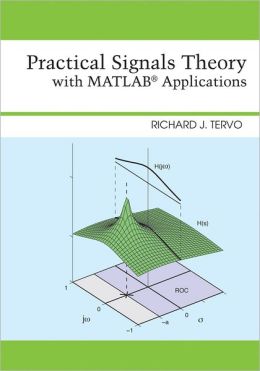 [内容简介]
[内容简介]
The 1st edition of Tervo’s Practical Signals Theory with MATLAB Applications offers an organized presentation around applications that introduces the actual behavior of specific signals and uses them to motivate presentation of mathematical concepts. The text sequences the presentation of the major transforms by their complexity to help visualize phenomena from an equation to develop intuition and learn to analyze signals by inspection. Furthermore the text provides examples and problems designed to use MATLAB, making presentation more in line with modern engineering practice.
Key features include: actual signal behavior presented first, from which mathematical theory is derived (most competitors do the opposite); an integrated CT/DT coverage; MATLAB integrated throughout; extensive use of innovative applications in examples and problems; and an emphasis on developing student intuition via analysis by inspection.
[目录]
Preface xix
Acknowledgments xxiii
1 Introduction to Signals and Systems 1
1.1 Introduction 1
1.2 Introduction to Signal Manipulation 3
1.3 A Few Useful Signals 9
1.4 The Sinusoidal Signal 17
1.5 Phase Change vs. Time Shift 21
1.6 Useful Hints and Help with MATLAB 25
1.7 Conclusions 26
2 Classification of Signals 30
2.1 Introduction 30
2.2 Periodic Signals 31
2.3 Odd and Even Signals 38
2.4 Energy and Power Signals 47
2.5 Complex Signals 52
2.6 Discrete Time Signals 56
2.7 Digital Signals 58
2.8 Random Signals 58
2.9 Useful Hints and Help with MATLAB 60
2.10 Conclusions 61
3 Linear Systems 66
3.1 Introduction 66
3.2 Definition of a Linear System 67
3.3 Linear System Response Function h(t) 73
3.4 Convolution 73
3.5 Determining h(t) in an Unknown System 88
3.6 Causality 91
3.7 Combined Systems 92
3.8 Convolution and Random Numbers 94
3.9 Useful Hints and Help with MATLAB 96
3.10 Chapter Summary 97
3.11 Conclusions 97
4 The Fourier Series 101
4.1 Introduction 101
4.2 Expressing Signals by Components 102
4.3 Part One—Orthogonal Signals 106
4.4 Orthogonality 107
4.5 Part Two—The Fourier Series 118
4.6 Computing Fourier Series Components 121
4.7 Fundamental Frequency Component 123
4.8 Practical Harmonics 126
4.9 Odd and Even Square Waves 128
4.10 Gibb’s Phenomenon 131
4.11 Setting Up the Fourier Series Calculation 132
4.12 Some Common Fourier Series 136
4.13 Part Three—The Complex Fourier Series 137
4.14 The Complex Fourier Series 138
4.15 Complex Fourier Series Components 143
4.16 Properties of the Complex Fourier Series 151
4.17 Analysis of a DC Power Supply 152
4.18 The Fourier Series with MATLAB 158
4.19 Conclusions 165
5 The Fourier Transform 171
5.1 Introduction 171
5.2 Properties of the Fourier Transform 178
5.3 The Rectangle Signal 181
5.4 The Sinc Function 182
5.5 Signal Manipulations: Time and Frequency 189
5.6 Fourier Transform Pairs 198
5.7 Rapid Changes vs. High Frequencies 200
5.8 Conclusions 203
6 Practical Fourier Transforms 206
6.1 Introduction 206
6.2 Convolution: Time and Frequency 206
6.3 Transfer Function of a Linear System 210
6.4 Energy in Signals: Parseval’s Theorem for the Fourier Transform 213
6.5 Data Smoothing and the Frequency Domain 215
6.6 Ideal Filters 216
6.7 A Real Lowpass Filter 220
6.8 The Modulation Theorem 224
6.9 Periodic Signals and the Fourier Transform 230
6.10 The Analog Spectrum Analyzer 233
6.11 Conclusions 235
7 The Laplace Transform 240
7.1 Introduction 241
7.2 The Laplace Transform 241
7.3 Exploring the s-Domain 243
7.4 Visualizing the Laplace Transform 251
7.5 Properties of the Laplace Transform 267
7.6 Differential Equations 267
7.7 Laplace Transform Pairs 270
7.8 Circuit Analysis with the Laplace Transform 272
7.9 State Variable Analysis 285
7.10 Conclusions 295
8 Discrete Signals 301
8.1 Introduction 301
8.2 Discrete Time vs. Continuous Time Signals 301
8.3 A Discrete Time Signal 303
8.3.1 A Periodic Discrete Time Signal 303
8.4 Data Collection and Sampling Rate 304
8.5 Introduction to Digital Filtering 319
8.6 Illustrative Examples 328
8.7 Discrete Time Filtering with MATLAB 338
8.8 Conclusions 340
9 The z-Transform 344
9.1 Introduction 344
9.2 The z-Transform 344
9.3 Calculating the z-Transform 348
9.4 A Discrete Time Laplace Transform 356
9.5 Properties of the z-Transform 358
9.6 z-Transform Pairs 359
9.7 Transfer Function of a Discrete Linear System 359
9.8 MATLAB Analysis with the z-Transform 360
9.9 Digital Filtering—FIR Filter 366
9.10 Digital Filtering—IIR Filter 373
9.11 Conclusions 378
10 Introduction to Communications 381
10.1 Introduction 381
10.2 Amplitude Modulation 385
10.3 Suppressed Carrier Transmission 394
10.4 Superheterodyne Receiver 398
10.5 Digital Communications 402
10.6 Phase Shift Keying 407
10.7 Conclusions 409
A The Illustrated Fourier Transform 411
B The Illustrated Laplace Transform 419
C The Illustrated z-Transform 425
D MATLAB Reference Guide 431
D.1 Defining Signals 431
D.2 Complex Numbers 433
D.3 Plot Commands 434
D.4 Signal Operations 434
D.5 Defining Systems 435
D.6 Example System Definition and Test 438
E Reference Tables 440
E.2 Laplace Transform 441
E.3 z-Transform 442
Bibliography 443
Index 445

 新书报道
新书报道